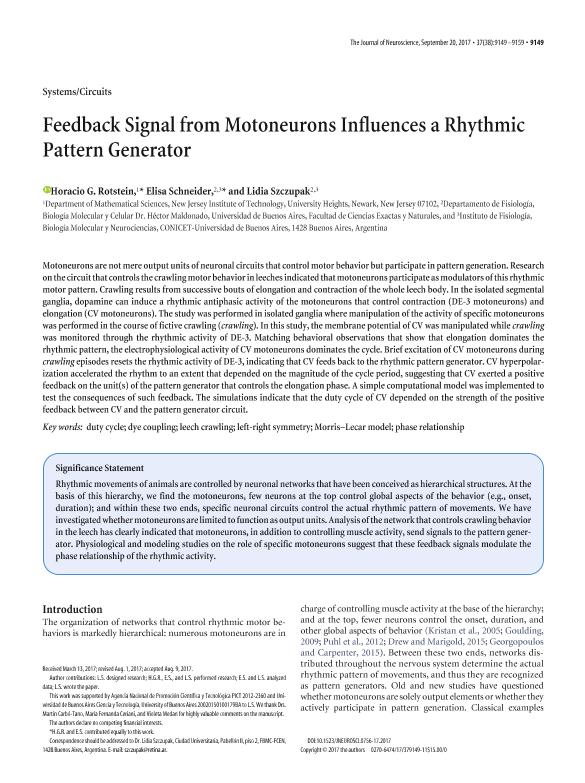Mostrar el registro sencillo del ítem
dc.contributor.author
Rotstein, Horacio

dc.contributor.author
Schneider, Elisa

dc.contributor.author
Szczupak, Lidia

dc.date.available
2018-12-04T14:34:37Z
dc.date.issued
2017-09-20
dc.identifier.citation
Rotstein, Horacio; Schneider, Elisa; Szczupak, Lidia; Feedback signal from motoneurons influences a rhythmic pattern generator; Society for Neuroscience; Journal of Neuroscience; 37; 38; 20-9-2017; 9149-9159
dc.identifier.issn
0270-6474
dc.identifier.uri
http://hdl.handle.net/11336/65703
dc.description.abstract
Motoneurons are not mere output units of neuronal circuits that control motor behavior but participate in pattern generation. Research on the circuit that controls the crawling motor behavior in leeches indicated that motoneurons participate as modulators of this rhythmic motor pattern. Crawling results from successive bouts of elongation and contraction of the whole leech body. In the isolated segmental ganglia, dopamine can induce a rhythmic antiphasic activity of the motoneurons that control contraction (DE-3 motoneurons) and elongation (CV motoneurons). The study was performed in isolated ganglia where manipulation of the activity of specific motoneurons was performed in the course of fictive crawling (crawling). In this study, the membrane potential of CV was manipulated while crawling was monitored through the rhythmic activity of DE-3. Matching behavioral observations that show that elongation dominates the rhythmic pattern, the electrophysiological activity of CV motoneurons dominates the cycle. Brief excitation of CV motoneurons during crawling episodes resets the rhythmic activity of DE-3, indicating that CV feeds back to the rhythmic pattern generator. CV hyperpolarization accelerated the rhythm to an extent that depended on the magnitude of the cycle period, suggesting that CV exerted a positive feedback on the unit(s) of the pattern generator that controls the elongation phase. A simple computational model was implemented to test the consequences of such feedback. The simulations indicate that the duty cycle of CV depended on the strength of the positive feedback between CV and the pattern generator circuit.
dc.format
application/pdf
dc.language.iso
eng
dc.publisher
Society for Neuroscience

dc.rights
info:eu-repo/semantics/openAccess
dc.rights.uri
https://creativecommons.org/licenses/by-nc-sa/2.5/ar/
dc.subject
Duty Cycle
dc.subject
Dye Coupling
dc.subject
Lecar Model
dc.subject
Leech Crawling
dc.subject
Left-Right Symmetry
dc.subject
Morris
dc.subject
Phase Relationship
dc.subject.classification
Otras Ciencias Biológicas

dc.subject.classification
Ciencias Biológicas

dc.subject.classification
CIENCIAS NATURALES Y EXACTAS

dc.title
Feedback signal from motoneurons influences a rhythmic pattern generator
dc.type
info:eu-repo/semantics/article
dc.type
info:ar-repo/semantics/artículo
dc.type
info:eu-repo/semantics/publishedVersion
dc.date.updated
2018-10-23T18:10:19Z
dc.journal.volume
37
dc.journal.number
38
dc.journal.pagination
9149-9159
dc.journal.pais
Estados Unidos

dc.journal.ciudad
Washington
dc.description.fil
Fil: Rotstein, Horacio. New Jersey Institute of Technology; Estados Unidos
dc.description.fil
Fil: Schneider, Elisa. Consejo Nacional de Investigaciones Científicas y Técnicas. Oficina de Coordinación Administrativa Ciudad Universitaria. Instituto de Fisiología, Biología Molecular y Neurociencias. Universidad de Buenos Aires. Facultad de Ciencias Exactas y Naturales. Instituto de Fisiología, Biología Molecular y Neurociencias; Argentina. Universidad de Buenos Aires. Facultad de Ciencias Exactas y Naturales. Departamento de Fisiología, Biología Molecular y Celular; Argentina
dc.description.fil
Fil: Szczupak, Lidia. Consejo Nacional de Investigaciones Científicas y Técnicas. Oficina de Coordinación Administrativa Ciudad Universitaria. Instituto de Fisiología, Biología Molecular y Neurociencias. Universidad de Buenos Aires. Facultad de Ciencias Exactas y Naturales. Instituto de Fisiología, Biología Molecular y Neurociencias; Argentina. Universidad de Buenos Aires. Facultad de Ciencias Exactas y Naturales. Departamento de Fisiología, Biología Molecular y Celular; Argentina
dc.journal.title
Journal of Neuroscience

dc.relation.alternativeid
info:eu-repo/semantics/altIdentifier/doi/http://dx.doi.org/10.1523/JNEUROSCI.0756-17.2017
dc.relation.alternativeid
info:eu-repo/semantics/altIdentifier/url/content
Archivos asociados
